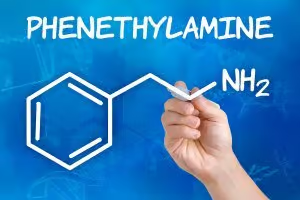Table of Contents
Key Takeaways
- Phenylethylamine (PEA) is a trace amino acid with stimulant and mood-enhancing effects, synthesized from L-Phenylalanine and found in certain foods and chocolate.
- PEA activates TAAR1 and TAAR2 receptors, leading to increased serotonin and dopamine release, potentially helping with anxiety, depression, and ADHD.
- Aging can lead to decreased PEA levels, which may be linked to ADHD, addiction, and neurodegenerative diseases.
- PEA shows promise as an antidepressant and a potential alternative to SSRIs, with ongoing studies for ADHD treatment.
- PEA has a short half-life, which can be extended by using it with a MAO-B inhibitor, and potential side effects include the “cheese effect” and other amphetamine-class side effects.
Phenylethylamine (PEA, 2-phenylethylamine, beta phenylethylamine / β-phenylethylamine, phenethylamine) is a trace amino acid. Your brain naturally converts L-Phenylalanine into Phenylethylamine (PEA).
PEA is not at the top of most nootropic stack choices because its effects are so short-lived. But some neurohackers love PEA for its stimulant and mood enhancing qualities.
The most famous promoter of phenylethylamine was Dr. Alexander Shulgin and his wife Anna. Dr. Shulgin published ‘PiHKAL: A Chemical Love Story’ in 1991. PiHKAL is short for “Phenethylamines I Have Known and Loved”.
Phenylethylamines are a group of phenethylamine derivatives which contain PEA as a backbone. These derivative compounds are formed by replacing one or more hydrogen atoms in the core structure.
This class of PEA compounds include amphetamines, empathogens, stimulants, psychedelics, appetite suppressants, bronchodilators, nasal decongestants, and antidepressants.
One of the more famous PEA derivatives is Methylenedioxymethamphetamine (MDMA or Ecstasy).
Dr. Shulgin developed, tested, and published the formulas for 179 different compounds largely based around the structure of PEA in his book PiHKAL.
In this review we investigate how phenylethylamine (PEA) works in the human brain.
Phenylethylamine helps:
- Anxiety & Depression. PEA activates TAAR1 and TAAR2 receptors which in turn prevents the uptake and boosts the release of the ‘feel-good’ neurotransmitters serotonin and dopamine.
- Neuroprotector. Monoamine oxidase inhibits the catecholamines like dopamine and norepinephrine. Decreases in dopamine levels are implicated in diseases like Parkinson’s. PEA helps boost dopamine and norepinephrine levels. Reducing the symptoms of neurodegenerative diseases.
- Attention Deficit Disorder (ADHD). PEA prevents the reuptake of dopamine and norepinephrine and inhibits their transport. Like the mechanism of action provided by ADHD stimulant meds. Some have found supplementing with PEA as a nootropic has decreased the symptoms of ADHD.
Overview
Phenylethylamine (PEA, 2-phenylethylamine, β-phenylethylamine, phenethylamine) is a trace amine naturally synthesized from L-Phenylalanine in your brain that links to your brain’s trace amine-associated receptor.

Aromatic amino-acid decarboxylase converts phenylalanine to phenylethylamine. This is the same enzyme that converts phenylalanine into dopamine. And it converts it at a rate comparable to the synthesis of dopamine.
But PEA is not retained in neuronal vesicles like dopamine is stored. Instead, monoamine oxidase-B (MAO-B) quickly degrades PEA.[i]
Despite its short half-life, PEA as a nootropic seems to be effective for increasing catecholamine activity by boosting dopamine and norepinephrine.[ii]
PEA can be found naturally in many cacao, algae, fungi, and bacteria as well as clover, beans, peas, and some food products such as Natto and eggs.
PEA is also found in chocolate where it is produced during cacao’s fermentation and roasting process.[iii]
PEA binds to C-protein-coupled receptors TAAR1 and TAAR2, receptors reserved specifically for trace amine use.[iv] These receptors are not used by other major neurotransmitters like dopamine or norepinephrine.
The half-life of PEA taken as a nootropic supplement is only 5 – 10 minutes.[v] Because it’s quickly degraded by monoamine oxidase-B (MAO-B).
Many neurohackers prolong the effects of PEA by using it with a monoamine oxidase-B inhibitor (MAOI) like selegiline (L-Deprenyl), hordenine, or Oat Straw.
How does Phenylethylamine work in the brain?
Phenylethylamine boosts brain health and function in several ways. But two in particular stand out.
- Phenylethylamine decreases depression. PEA naturally boosts the ‘feel-good’ neurotransmitters in your brain called serotonin and dopamine. Studies have shown that depressed patients when tested have lower levels of PEA.[vi]
In fact, some suggest that a PEA deficit may be the cause of depression in the first place. One study had 14 patients with major depression take up to 60 mg per day of Phenylethylamine (PEA) along with 10 mg of selegiline (L-Deprenyl) for up to 50 weeks.
Researchers found that “PEA produces sustained relief of depression in a significant number of patients, including some unresponsive to the standard treatments. PEA improves mood as rapidly as amphetamine but does not produce tolerance.”[vii]
- Phenylethylamine is a mesencephalic enhancer. PEA is considered a mesencephalic enhancer which is defined as “enhancer-sensitive neurons in the brain capable of working in a split-second on a high activity level due to endogenous enhancer substances”.[viii]
This means that PEA stimulates the release of dopamine, norepinephrine, and serotonin in the brain. But unlike stimulant drugs like amphetamine, which release a flood of these neurotransmitters in an uncontrolled manner.
PEA instead only increase the amount of neurotransmitters that get released when a neuron is stimulated by receiving an impulse from a neighboring neuron.
In other words, the pattern of the neurotransmitter release in not changed. But when the neuron would normally release a neurotransmitter, a larger than normal amount is released.[ix]
The result is nearly instantaneous improvements in cognitive performance, attention, awareness, pleasure, libido, and a sense of well-being.
Phenylethylamine is an endogenous (natural or ‘built-in’) amphetamine. This mechanism of action is how prescription ADHD stimulants like Adderall work. And the basis for many Schedule 1 drugs like MDMA[x], LSD, mescaline, and (crystal) methylamphetamine.[xi]
How things go bad
Phenylethylamine (PEA) is naturally metabolized by monoamine oxidase-B (MAO-B). But as we get older, MAO-B levels rise and suppress healthy levels of PEA.
Low PEA levels have been linked to several neurological diseases. And may result in:
↓ Increased chance of ADHD
↓ Increased chance of addiction
↓ Energy levels decline
↓ Working memory and mood decline
↓ Contributing to Parkinson’s Disease
On the other hand, excess levels of PEA has been linked to migraines and paranoid schizophrenia.
Phenylethylamine central nervous system benefits
Phenylethylamine (PEA) quickly crosses the blood-brain barrier once you take it. And you feel its effects right away.
 Activation of TAAR1 receptors inhibit the uptake and induces the release of dopamine, norepinephrine, and serotonin. It’s like turning up the volume of neuron activity.
Activation of TAAR1 receptors inhibit the uptake and induces the release of dopamine, norepinephrine, and serotonin. It’s like turning up the volume of neuron activity.
A higher concentration of all of these neurotransmitters increase feelings of pleasure, boosts motivation, improves memory and cognition, and reinforces impulse control.
PEA naturally maintains and regulates neuronal activity. Preventing over- or under-stimulation. When working as designed, PEA and other trace amines prevent metabolic dysfunction and neurological disorders.
As a neurotransmitter, PEA acts like, and looks similar to amphetamines. And produces effects normally associated with taking a stimulant (like the drug amphetamine Adderall). But unlike amphetamines, and because PEA is endogenous to the brain, side effects and tolerance are avoided.
PEA works in an area of the brain associated with emotions. Resulting in feelings of pleasure, more drive and impulse control, heightened creativity, and better sensory perception.
PEA improves libido, social behavior, a sense of wellbeing, and better overall performance.
PEA is currently being studied and used for the treatment of ADHD, depression, bipolar disorder, cognitive dysfunction like brain fog and poor concentration. And PEA looks promising for treating addiction and eating disorders.
How does Phenylethylamine feel?
PEA is rapidly broken down by monoamine oxidase-B (MAO) so unless you stack PEA with a brain chemical like a MAO-B inhibitor, don’t expect its effects to last. Most experience a peak within 15 minutes and sustained energy for 30 min. to an hour.
If you’re ADHD or ADD, you should see an improvement in mood, attention span, focus and mental clarity. Not quite the same effect you’d get from something like Adderall but with a side benefit of more sociability.
Neurohackers report taking a monoamine oxidase inhibitor (MAOI) supplement 15 minutes before a PEA dose and the effects should last about 2 hours. And there’s no crash like you’d normally experience with a stimulant. Just a general feeling of well-being once it wears off.
Some have reported PEA helped kick the habit of Phenibut or caffeine without going through withdrawal.
As a pre-workout supplement, PEA provides a more intense and focused workout.
Older neurohackers seem to feel even more benefit when using PEA. Likely because monoamine oxidase levels over-power dopamine the older you get. And using PEA, especially with a MAOI helps restore dopamine, the brain chemical called serotonin, and other neurotransmitters that are typically depressed with age.
PEA is a great nootropic for study because you should feel less anxiety, fewer panic attacks and less stress. And more motivation, a better mood, easier to maintain focus, and more energy.
Some report food cravings subside and it’s easier to lose weight.
Phenylethylamine Clinical Research
Phenylethylamine as an Antidepressant
Depression is the 2nd leading cause of disability among ages 15 – 44. By 2030, the World Health Organization predicts depression will be the leading cause of disability worldwide.[xii]
Selective serotonin reuptake inhibitors (SSRI) are the most popular antidepressants prescribed worldwide. SSRIs work by blocking the serotonin transporter and inhibiting the reuptake of the neurotransmitter in your brain called serotonin. Resulting in an increase of serotonin in synapses.
But the problem is SSRIs are slow to act. And come with a host of side effects. The sustained antidepressant effect of Phenylethylamine (PEA) may be an alternative to SSRIs.
A study done in 2008 showed that PEA alters serotonin transporters by interacting with TAAR receptors. Increasing serotonin levels by preventing their reuptake just like prescription SSRIs.
The study suggested that PEA may be a safer treatment for depression than SSRIs.[xiii]
Phenylethylamine for ADHD
The diagnosis of attention deficit hyperactivity disorder (ADHD) has traditionally been done by analysis of symptoms. But measuring PEA levels instead has recently been described as a possible biomarker for diagnosing ADHD.[xiv]
This discovery of a relationship between PEA levels and ADHD has excited researchers. Because it will hopefully improve levels of confidence during ADHD diagnosis. And reduce misdiagnosis and over-medication.
One study of ADHD children medicated with methylphenidate (Ritalin) had significantly higher PEA levels when using methylphenidate.[xv]
PEA binds to the TAAR1 receptor which alters monoamine transporter function. And leads to the inhibition of the reuptake of dopamine, serotonin, and norepinephrine. Which then increases the concentration of these neurotransmitters in neuron synapses.[xvi]
This increase in synaptic concentrations of dopamine can be accomplished by directly blocking the dopamine transporter. Which is how drugs like methylphenidate work to boost dopamine.
So if you are ADHD and crave chocolate, it’s likely because cocao supplies PEA.
Some naturopaths are beginning to prescribe PEA instead of stimulants like amphetamines or methylphenidate to treat ADHD.
Phenylethylamine Dosage
 Phenylethylamine (PEA) suggested dosage for cognitive benefit is 500 mg up to 3-times per day.
Phenylethylamine (PEA) suggested dosage for cognitive benefit is 500 mg up to 3-times per day.
PEA has a half-life of 5 – 10 minutes.[xvii] But the effects of PEA can be extended by using it with a MAO-B inhibitor.
If you do use a potent MAOI like selegiline (l-deprenyl) make sure you keep the dose low (i.e. 2.5 mg) or you’re in danger of inhibiting MAO-A as well. More on the “cheese effect” next.
Dosing more than recommended is NOT a good idea because you’ll likely feel jittery, irritable, get a headache, feel nausea, and very possibly force your heart rate to dangerous levels.
Phenylethylamine Side Effects
“Cheese effect”: Phenylethylamine (PEA) is metabolized by the enzyme MAO-B. And when monoamine oxidase (MAO) is inhibited by eating cheese, or any other prescription or natural MAO inhibitor (MAOI), the combination can result in a potentially dangerous increase in blood pressure.[xviii]
Studies show that selective MAO-B inhibition does NOT produce this cheese effect.[xix]
Examples of MAO-B selective inhibitors include low-dose selegiline (L-deprenyl), hordenine, Polygala Tenuifolia, Oat Straw, Glycyrrhiza uralensis (Chinese licorice root extract), Phellondendron amurense (Amur cork tree bark), Ferula assafoetida extract (resin), and Psoralea corylifolia (Bu Gu Zhi).[xx]
Do not use Phenylethylamine (PEA) if you are using a prescription MAOI like Marplan, Nardil, Azilect or Parnate, or have used one in the last 14 days.
Do not use PEA if you have phenylketonuria (PKU).
Too much PEA can cause irritability, nausea, amplified heart rate, jitteriness, and could be extremely dangerous.
Remember, Phenylethylamine (PEA) is a (natural) endogenous amphetamine. And used irresponsibly could produce the same dangerous side effects as anything else in the amphetamine-class of compounds.
Where to buy Phenylethylamine
Phenylethylamine (PEA) is available in capsules, tablets, and as a bulk powder.
DO NOT make the mistake of buying Phenylalanine instead of Phenylethylamine (PEA). Because it’s NOT the same thing. And is easily overlooked when searching for this nootropic.
You can buy Phenylethylamine in powder form from Bulk Supplements.
If you buy PEA in powder-form, you should invest in a capsule machine and make capsules. Because PEA is a particularly nasty tasting nootropic supplement.
Nootropics Expert Recommendation
 Phenylethylamine 500 mg up to 3-times per day
Phenylethylamine 500 mg up to 3-times per day
I recommend using Phenylethylamine (PEA) as a nootropic supplement.
Your body does synthesize some Phenylethylamine from phenylalanine which comes from foods like beans, cacao, peas, Natto and eggs.
But most of us don’t get enough Phenylethylamine from our diet. So supplementation could help. Phenylethylamine is highly bioavailable, and quickly crosses the blood-brain barrier. So you should feel its effects soon after you take it.
Phenylethylamine is helpful for most neurohackers to combat anxiety, stress, and sleep deprivation. It’ll boost dopamine, norepinephrine, and serotonin levels.
It’s particularly helpful if you take Phenylethylamine prior to a stressful situation, workout, or physically demanding job. And it’s a great nootropic for studying.
Phenylethylamine could be helpful to those dealing with ADHD/ADD. It’s a possible substitute to stimulant meds like Ritalin or Adderall for some people.
PEA will provide the dopamine your brain needs. And doesn’t produce the stimulant crash when it wears off.
PEA works well when stacked with L-Tyrosine (for dopamine), and CDP-Choline and ALCAR (for acetylcholine).
PEA is quickly degraded by monoamine oxidase-B. So to prologue its effects, stack it with a low-dose MAOI-B.
You can buy Phenylethylamine in powder form from Bulk Supplements.









Join The Discussion - 188 comments
Angela
August 10, 2020
Hi,
I’ve read some information online that taking adderall or stimulates can trigger actual full blown schizophrenia in people who may be pre disposed to it, because of their family history.
I’ve also heard that stimulants can trigger psychotic episodes in people even in they don’t have schizophrenia or a family history of it. It’s not clear to me if this is supposedly a temporary or long term effect even after you stop taking them.
As I said I read this online and am not sure if this information is accurate or not. As a side note,I would appreciate your thoughts about this too. If it is accurate information, does PEA work in the same way as stimulates, as far as this goes?
I have an identical twin sister who may possibly have schizophrenia(Please keep in mind that I don’t actually know if she has it for sure, my thoughts are based only on my own online research and limited knowledge as to how it could present), she has been diagnosed with PTSD so from my research rather than schizophrenia, even possibly more likely she has PTSD with psychotic features. I had a short time in my teen years that I had some temporary visual psychosis. I believe this may have have been caused by a terrible trauma I was living through at the time. I’m 44 years old and have experienced nothing like that since than.
Do you think taking PEA could be a concern for me, also would you please explain your reasoning as to why it may or may not be a concern?
I have adhd and some depression. I would really would like to try PEA.
If this may be an actual concern for me, would you please give me some other nutropic options for adhd and depression that may be a better option for me?
David Tomen
August 11, 2020
Angela, Phenylethylamine (PEA) is an endogenous (natural) amphetamine. So it could cause the same types of problems that any amphetamine could especially in high doses.
Depression is often a “side effect” of ADHD. And if you take care of the ADHD symptoms the depression may subside. This is how you control ADHD/ADD symptoms with nootropics: https://nootropicsexpert.com/best-nootropics-for-adhd-add/
Jonas
June 14, 2020
Hello David, I live in Europe and cannot find any PEA supplement, I am wondering whether it has been banned? I can’t find any legal information about this. Do you think algae such as Phanizomenon flos-aquae (AFA) (Klamin) are a good source of PEA?
David Tomen
June 15, 2020
Jonas, PEA is found naturally in cacao, algae, fungi, and bacteria as well as clover, beans, peas, and some food products such as Natto and eggs. PEA is also found in chocolate where it is produced during cocao’s fermentation and roasting process. But I’m not sure of how much PEA is each of these sources.
I’m not sure of the legality of PEA in Europe. It wouldn’t surprise me if it’s banned because it’s the source of, or in the same family of compounds from which amphetamines including MDMA are made.
FiachraW
May 30, 2020
Hi David,
I am looking at a product called eria jarensis and in the description it claims that it induces Phenylethylamine
Do you have any experience with this product or its effects?
Thanks,
Fiachra
David Tomen
June 1, 2020
Fiachra, it appears the Eria Jarensis (N,N-Dimethylphenethylamine) is extracted from the orchid Eria jarensis. And is either a precursor to the synthesis of dopamine and norepinephrine. Or acts on the Trace amine-associated receptor 1 (TAAR1) which regulates the way dopamine works in your brain.
Eria Jarensis extract seems to be popular in the athletic world as a natural stimulant. But chances are because it’s in the same family as other PEA compound it’s likely to be banned sooner or later.
Sharon
February 22, 2020
wonderful article – thank you! Do you think PEA can help with menopausal depression and poor sleep? Mine is clearly tied to moon cycles. Wondering if I cycle this, if it will help? I am taking Rhodiola for my adrenals, so sounds like that might be a beneficial combination.
David Tomen
February 23, 2020
Sharon, not sure how PEA would help you because it’s half life is only 5 – 10 mins. So if it does provide some benefit it will be very short-lived.
PMS depression is often caused by hormones that have gone out of whack. Another symptom is insomnia. Treating this type of depression is difficult because the only long-term solution would be getting your hormones back where they should be.
It’s true that sex hormones affect how the brain works. But it’s not a direct association to neurotransmitters that are out of balance.
See my post on Best Nootropics for Depression which may be more helpful: https://nootropicsexpert.com/best-nootropics-for-depression/
chris
February 16, 2020
hello David,
I got a question about dosages of pea, I gave it a try myself and I recommended it to my parents to also give it a try and they love it too, they’ve asked me could the dosage be increased from 0.5g 3x a day to 1g 3x a day, I don’t know if that’s a good idea what do you think about it?
age group 45-50.
David Tomen
February 16, 2020
Chris, the highest dose for Phenylethylamine I can recommend is 500 mg up to 3-times per day. This is based on many hours of research.
Too much PEA can cause irritability, nausea, amplified heart rate, jitteriness, and could be extremely dangerous.
Chris
February 16, 2020
That’s exactly what I was thinking, thank you for confirmation and thank you for being here, spreading the knowledge, helping us stay safe and healthy.
Chris
February 17, 2020
One more question, I couldn’t find anything about this on the internet, can you still take ur daily dosage while intending to drink alcohol like vodka or whiskey on weekends?
David Tomen
February 18, 2020
Chris, honestly not sure. I’m not aware of any contraindications with alcohol. But my gut tells me it may be a dangerous combination. I’d be very careful with testing this if I were you.
Henry
February 7, 2020
Hi David
With regard to phenylethylamine would Rhodiola Rosea suffice as an MOA B inhibitor?
David Tomen
February 7, 2020
Henry, it may because Rhodiola Rosea does act like a MAOI. But doubt it’ll be as effective or as strong as using something like selegiline (L-deprenyl).
Aldo
February 2, 2020
Hello David,
I bought it bulk and tried it but the first time I used it (less than half of a teaspoon) I got little fast heart rate and felt dizzy and feeling was not good. I then tried just a pinch of it and feel anything. Could it be I took too much or I am alergic to it?
Thanks
David Tomen
February 2, 2020
Aldo, please go back up to the top of this review and re-read the bullets and next few paragraphs starting at “Phenylethylamine helps:”
That happens in less than 10 minutes. In fact, PEA’s half-life is 10 mins. So you are getting a flood of neurotransmitters. The same ones affected by compounds such as MDMA and Ecstasy.
You may not be “allergic” to this nootropic. But only very sensitive to it. As are many others sensitive to the effects of some nootropics.
A ‘normal’ minimum dosage of this nootropic is 500 mg. It sounds like you used considerably less than that and are just too sensitive to it. It may not be the right nootropic for you.
Adam Phytophile
November 16, 2019
Great summary and article. I have used PEA on its own as well as with Rx Selegiline (L-Deprenyl) with positive effects. One thing I feel is notable is that the dosage required for perfectly significant effects is much lower when combined with a strong MAOBI like Selegiline. 60-100mg is plenty for an amphetamine-like boost in concentration without the side effects or crash. 500mg, IME, would be far too high and lead to issues like vasoconstriction, hypertension, jitteriness or anxiogenesis. The combination has done wonders for depression and focus/fatigue issues associated with a neuromuscular and chronic inflammatory condition. Much better than amphetamines, the side effects of which make some of my symptoms worse.
I think there is also great potential for using PEA + Selegiline in the treatment of amphetamine/methylamphetamine addiction, as it can prevent the anhedonia and other symptoms of withdrawal, and Selegiline itself has been shown to repair and regenerate dopaminergic neurons damaged specifically by neurotoxicity associated with amphetamine abuse.
It should be noted that the doses of Selegiline (around 2-5mg) are assuming high bioavailability, such as sublingually, or transdermally with a patch. Oral Selegiline has about 30% bioavailability, so approximately 3x the dose is required. One should still not exceed 15mg orally, lest one be susceptible to lower doses and risk reversing the selectivity and inhibiting MAO-A as well.
Thanks for the article, Regards.